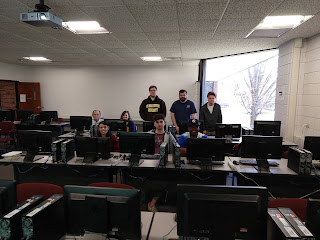For Immediate Release:
ST. BONAVENTURE, N.Y., April 13, 2018 — St. Bonaventure University will unveil the Western New York Cybersecurity Research Center on Tuesday, April 24.
More than 150 people, including politicians, business leaders and educators, are expected for the ribbon-cutting ceremony, which begins with a program at 9 a.m. and concludes with a networking reception at 11 a.m.
Scientists will gather on campus Monday, April 23, for a workshop to explore research opportunities the center can offer.
The center is located in the former Records and Registrar offices in Doyle Hall.
The WNY Cybersecurity Research Center is a collaboration between St. Bonaventure, National ICT Japan, Canadian Institute for Cybersecurity and New Zealand Cybersecurity Center.
The center will engage in cybersecurity research using various state-of-the-art technologies including machine learning, data mining and opinion mining.
The center will do monitoring, alerting and forecasting to help make Western New York safer from cyberattacks, said Dr. Hossein Sarrafzadeh, director of St. Bonaventure’s cybersecurity program.
The university partnered two years ago with Hilbert College to begin offering a Bachelor of Science degree in cybersecurity. Sarrafzadeh was the founder and co-director of New Zealand’s first Cybersecurity Research Center.
Sarrafzadeh joined the university in June 2017 and immediately began envisioning what a research center focused on cybersecurity could mean for St. Bonaventure.
“What Dr. Sarrafzadeh has accomplished in his short time here is truly remarkable,” said Dr. Dennis DePerro, president of St. Bonaventure. “His conviction that this center could be a critical step in developing our cybersecurity program has driven this project. This will have a tremendous impact not only on our students, but on businesses and organizations that can benefit from the services the center provides.”
The center will have two functions: as a center for faculty and students to perform research, and as a Security Operations Center (SOC) to provide monitoring services to external clients. The SOC is scheduled to open in the fall.
The SOC will be operated in partnership with Buffalo-based Silo City IT, a managed security service provider and solutions architecture firm specializing in artificial intelligence-based solutions. Jeff Rathmann, SBU Class of 2007, is president and CEO of Silo City.
The SOC will provide 365/24/7 continuous monitoring and defense, email defense, managed endpoint security, managed email defense, threat hunting and intelligence, incident response, managed security automation and customer support.
The SOC will give students the opportunity to gain real-life work experience while they study, Sarrafzadeh said. Students will be screened and trained rigorously before working in the SOC.
“The center will become a Western New York success story in cybersecurity,” Sarrafzadeh said. “The center will help raise the awareness of cybersecurity risks in local communities and businesses.”
Demand for cybersecurity professionals is expected to rise to 6 million globally by 2019, with a projected shortfall of 1.5 million, said Michael Brown, CEO at Symantec, the world’s largest security software vendor.
U.S. News & World Report ranked “information security analyst” third among the best technology jobs, eighth among the top 100 professions and 15th among the highest-paying jobs.
“The center will provide advanced and up-to-date training and education for those wanting to pursue a career in cybersecurity or those wishing to retrain and take advantage of the highly paid jobs in this field,” Sarrafzadeh said. “It will also strengthen the university as a leading provider of industry training.”
Students will also have opportunities to travel to Japan, Canada and New Zealand and work on cutting-edge equipment, he said.
The center also plans in the future to offer short courses and seminars for the public to combat cybersecurity risks.
______________
About the University: The nation’s first Franciscan university, we believe in the goodness of every person and in the ability of every person to do extraordinary things. St. Bonaventure University cultivates graduates who are confident and creative communicators, collaborative leaders and team members, and innovative problem solvers who are respectful of themselves, others, and the diverse world around them. Named the #5 best college value in the North by U.S. News and World Report, we are establishing pathways to internships, graduate schools and careers in the context of our renowned liberal arts tradition.

























